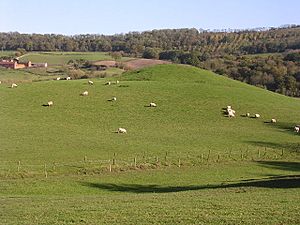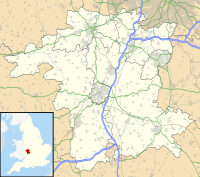Ham Castle facts for kids
Quick facts for kids Ham (or Homme) Castle |
|
|---|---|
| Clifton-upon-Teme, Worcestershire | |

Homme Castle mound, 2005
|
|
| Coordinates | 52°15′19″N 2°23′24″W / 52.25526°N 2.39001°W |
| Type | Motte and bailey |
| Site information | |
| Open to the public |
Yes |
| Condition | Earthworks only survive |
Ham Castle, also known as Home or Homme Castle, is a historic site in Worcestershire, England. It's located near the village of Clifton-upon-Teme, close to the River Teme. This castle was a type of medieval fortress called a motte and bailey castle. Today, only earthworks, like a large mound, remain of this once important stronghold. In the 1600s, a secret stash of gold and silver from the Middle Ages was found here!
Contents
Exploring Ham Castle's Remains
The remains of Ham Castle are found in a field that slopes downwards. The main part of the castle was a large, oval-shaped mound called a motte. This mound is about 56 meters (184 feet) long and 40 meters (131 feet) wide. It might even have a natural rock inside it.
The motte is surrounded by a flat area called a bailey. The height of the motte changes depending on where you measure it. On one side, it's about 2 meters (7 feet) tall, but on another, it can be up to 4.2 meters (14 feet) high. The top of the motte is flat and covered in grass.
Long ago, there was also a double moat around the castle. This moat was filled with water from a nearby spring and the River Teme. Over many years, farming has made it hard to see the old walls or buildings that were once in the bailey.
The History of Ham Castle
Ham Castle was a very important stronghold long ago because of its strong position. But not much is known about its early days.
Early Mentions of the Castle
The castle is first mentioned in records in the year 1207. It belonged to the owners of the Ham manor (a large estate). However, for some reason, King John took the castle from them. He then gave it to a person named Thomas de Galweya. In 1207, King John ordered Thomas to hand over the castle to William de Cauntelow. William was to look after it for the King.
After this, there aren't many direct mentions of the castle itself. In 1288, a legal document talks about land in "Castel Homme." This shows the castle was still known by its name.
The Castle During the Civil War
The castle was badly damaged during the English Civil War in the 1600s. People say the Parliament army attacked it. Cannonballs, which are big metal balls fired from cannons, were even found nearby.
A woman named Mistress Joyce Jeffreys lived at Ham Castle during the war. She wrote in her diary about hiding her belongings. She would bury her trunks and other things when the enemy was near. This led to an amazing discovery!
The Discovery of Treasure
One time, when burying things, William Jeffreys, who owned Ham Castle, found a hidden chest. It was full of "gold and silver and other kind of mettalls." This chest was found in a secret vault. The vault was in the middle of an "ancient fort made in the fashion of a half moon." It seems someone had buried this treasure long before, perhaps during another time of danger.
General Gilbert Gerrard, who was the Governor of Worcester, also visited Ham Castle during the war. He stayed there for a day in July 1645.
What Happened to the Castle?
By the 1600s, Ham Castle was already described as "ruined." A new house was built on the site of the old castle. This house was partly burned in 1605 and then badly damaged during the Civil War. It was rebuilt around 1677 and 1680. This new house was also destroyed by fire in 1887.
Even though the house was changed a lot before it was destroyed, it still had signs of its grand past. It had a huge staircase, oak bookshelves in the library, and beautiful garden terraces. Today, only the earthworks of the original medieval castle remain.


